Informing the new conservation agenda
The 14th NBN Conference ‘Climate, Collaboration and Collection’, held in the Royal Society, London on Friday 21st November, was a chance to bring together 170 delegates representing the diversity of the NBN to discuss the new direction of travel, catch up with colleagues from across the Network, listen to a series of thought provoking talks and most of all, celebrate how far we have come and talk about the future of the National Biodiversity Network under the new NBN Strategy. The energy at the Conference was one of excitement and anticipation and there could be no doubt that collaboration was the word for the day.
Delighted to be sponsoring #nbnconf14 at the Royal Society and having a great day!
— Nick Mann (@Habitat_Aid) November 21, 2014
NBN Trust Chairman, Professor Michael Hassell opened the conference by welcoming the delegates and thanking the sponsors of the Conference, Habitat Aid and CEH, and the sponsors of eight student places, LUC and Bangor University.
Professor Ian Boyd, Chief Scientific Adviser at Defra gave the Keynote address ‘Biodiversity, habitats and Earth Observation: futures for Big data in the UK’. He demonstrated how data from the NBN is used to support both national and international reporting and reiterated that the Defra family cannot deliver on protecting the countryside without the NBN community. His Keynote address was the start of a common thread that ran throughout the conference – ‘we need a community based approach to data collection’ and collaboration is, and will continue to be, our key to success.
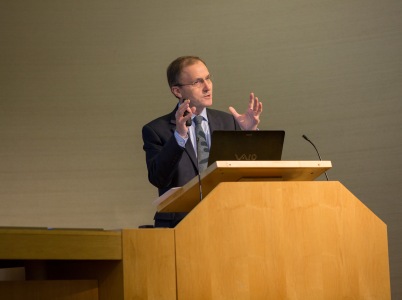
Download Ian Boyd's presentation
Katie Winney, Conservation Information Officer (Insights), National Trust brought the conference from a high level look at the Network, to a more focussed look at data collection in her talk ‘Biological recording in a changing world. Collecting data through to managing for change on National Trust land’. To date, National Trust have submitted 260,000 species records to the NBN Gateway and yet they still have many more records held in a wide variety of formats from their diverse land holdings. Katie raised some challenging questions within her talk and asked ‘are we thinking ahead and recording those habitats which are being rapidly colonised with a change in our climate?’. The National Trust are building on the Lawson Report by taking a bigger, better and more joined up approach to monitoring and recognise that the more people who are involved in biological recording, the more data that can collect, but the big challenge for us all is ‘how do we get more people involved?’.
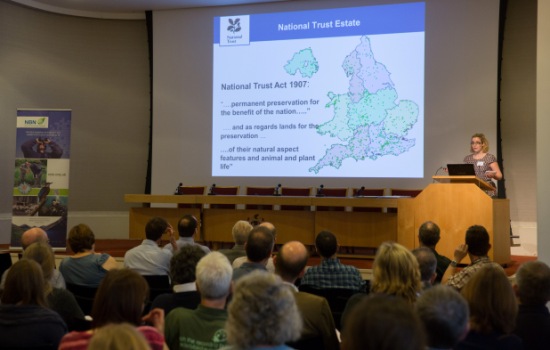
Download Katie Winney's presentation
#nbnconf14 familiar problem for NT, how do you know what people are recording on your land if they don't tell you?
— Will George (@WillhGeorge) November 21, 2014 The morning continued with an inspiring talk from Matt Davies, Operations Manager, Greenspace Information Greater London (GiGL) demonstrating that Local Record Centres are not just about ‘records’. He showed the scale and breadth of projects which GiGL is involved in from working with the London Fire Brigade providing fact sheets to allow their fire officers to take into account sensitive species in their work to mapping garden land across London and informing the appropriate plantation of 10,000 street trees within the City. Matt’s message to all was that ‘through collaboration, innovation and engagement, LERCs can become the local nodes of NBN and support the NBN in delivering the Strategy and creating the NBN we all want.’
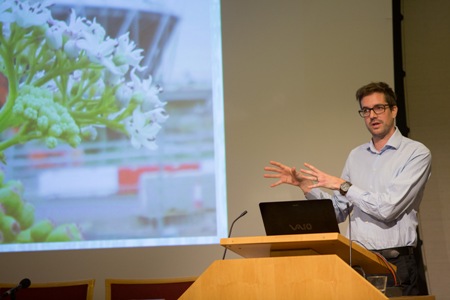
Download Matt Davies' presentation
Matt from London's LERC @iGiGL summing up what LERC's are all about – turning data into information and engaging people #NBNConf14
— Biodiversity Data (@CumbriaBDC) November 21, 2014 With a revised format this year, a morning and afternoon break allowed more opportunities for networking and visiting the displays and demonstrations.
After the first break three special awards were made. Firstly, Honorary Membership was given to Dr James Munford, the NBN Trust’s former Chief Executive, for his work and success in guiding the NBN to where it is today. A second Honorary Membership award was given to Val Burton for her behind the scenes work in computerising 12 million records from hand written cards and notebooks! Unfortunately Val was unable to join us to receive her award, but we hope we can share a photo of her receiving it at a later date. The final presentation was given to the recorder of the 100 millionth species record to be uploaded to the NBN Gateway, Peter Kirby.
From a local scale, to a global scale, after the morning break Peter Doherty, Programme Manager at Atlas of Living Australia talked to the NBN community about the approach that Australia has taken to create simple, usable tools to display and utilise Australian biological records. Peter demonstrated that opening up data leads to innovation with the development of apps such as ‘QuestaBird’. The Atlas of Living Australia has been able to create a flexible infrastructure to support this innovation, an infrastructure so flexible that it is being implemented across the globe. Advanced analysis of data and a dynamic dashboard of statistics has enabled data providers to communicate with funding bodies and the NBN Trust are excited to be able to learn from Peter and his team in informing the development of the NBN Gateway.
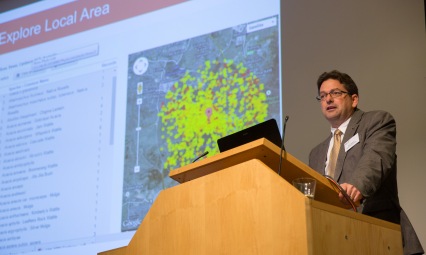
Download Peter Doherty's presentation
A new approach for the NBN conference saw the introduction of 5-minute speed talks. These lightning talks saw four speakers cover a range of topics, in a short space of time. John Tweddle, Head of Angela Marmont Centre, Natural History Museum talked about the collaborative project between NHM, NBN Trust and FSC ‘Identification Trainers for the Future’ – a project to support early career scientists to become the recorders of the future, as well as creating a multiplier effect to ‘train the trainers’.
Download Tohn Tweddle's presentation
Next up was Lori Lawson Handley from University of Hull and while still talking on the topic of the future of biological recording, this time introducing many in the audience for the first time to the molecular revolution.
Download Lori Lawson Handley's presentation
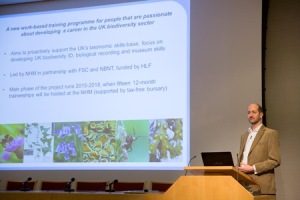
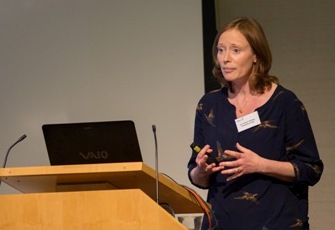
Next to the podium was Chris Raper, the UK Species Inventory Manager. Chris introduced the UK Species Inventory, and the importance of the Inventory in the core of the NBN family of projects. Chris is dedicated to making sure the data in the Inventory is as up to date and as available as possible and is working with the NBN Trust to bring the Inventory online to create a personal interface with the users and the database.
Download Chris Raper's presentation
Finally, Charles Roper, Technical Lead at Sussex Biodiversity Record Centre, talked about Open Data and the Future of Data Sharing. Open data is at the stage today where the World Wide Web was at 20 years ago and Charles delivered an inspiring, and timely, presentation highlighting that good open data is liquid – it flows, and asked ‘how can the NBN be more open?’
Download Charles Roper's presentation

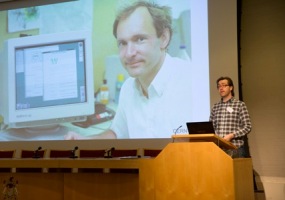
Passionate performance poetry from @charlesroper to enthuse about open data #NBNConf14
— iSpot (@iSpot_uk) November 21, 2014 

After an opportunity to catch up with one another and visit the displays and demonstrations over lunchtime, the afternoon session was kick-started with the The Sir John Burnett Memorial Lecture 2014, given by Professor Chris Thomas from the University of York. Chris’ lecture ’Biodiversity Change and Conservation in the Anthropocene’ was challenging and thought provoking and asked where are we in terms of environmental change and our role in biological recording in changing perceptions. There is uncertainty around the future changes of species and their range in light of climate change, and a huge proportion of the world’s species rely on moving to survive. Chris asked the challenging question ‘is climate change a welcome diversifying of our fauna and flora?’. The lecture concluded by reiterating that we must all be careful when setting environmental baselines in such an ever changing environment and these baselines have the potential to skew our understanding of the world.
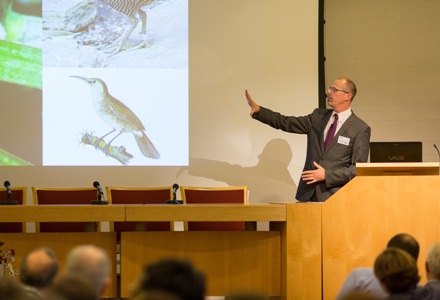
Download Chris Thomas' presentation
After the presentation of the Sir John Burnett Memorial Medal to Professor Chris Thomas, Dave Goulson, University of Sussex raised yet more challenging questions on ‘Pollinator monitoring (or lack of it) and climate change’. Dave demonstrated that it is difficult to get a full understanding on populations from maps alone and we need a collaborative approach to pollinator monitoring. His lasting message was that we need to do something, rather than just talking about it!
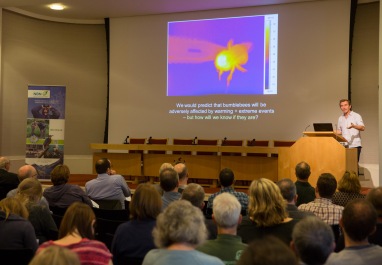
Download Dave Goulson's presentation
Savita Custead, Chief Executive, Bristol Natural History Consortium demonstrated how to turn words into action by presenting the future of recording and BioBlitz events. Savita asked an interesting question to the audience when talking about engaging with hard to reach audiences. “Are the NBN a hard to reach audience? Who is currently trying to find us and engage with us?!”
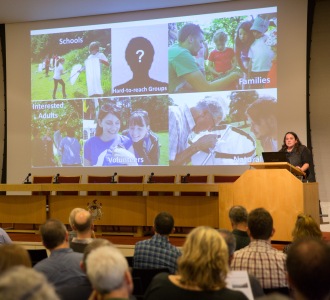
Download Savita Custead's presentation
Richard Pywell, Senior Principal Scientist at NERC Centre for Ecology & Hydrology spoke on the use of biological records to answer pressing environmental challenges and he drew together much of the content of the earlier talks . We are in a position to be able to model future distributions of species in the face of climate change, and a key role for the volunteer community is to use emerging technology to track the arrival of Invasive Non-native Species. Richard stressed that biological records from volunteers are valuable for researchers and while researchers are demanding more of the data, with closer collaboration we can integrate both ad hoc and structured sampling datasets to undertake robust analysis.

Download Richard Pywell's presentation
Richard Pywell flagging up our work on the impacts of the Harlequin ladybird – 2-spot ladybird distribution down 44% in 5 yrs #NBNConf14
— Richard Comont (@RichardComont) November 21, 2014 The closing talk was given by John Sawyer, Chief Executive NBN Trust. In his talk ‘Refreshing the NBN strategy – delivering a data driven partnership for nature’, John outlined the need to change, discussed the challenges being faced by the Network both externally and internally and provided an overview of what the NBN Trust has heard to date in light of the new NBN Strategy. The NBN revolution is starting and John delivered a strong and powerful message to the NBN that each and every one of us need to “Ask not what NBN will do for you, but what, together, we can do for the NBN”.
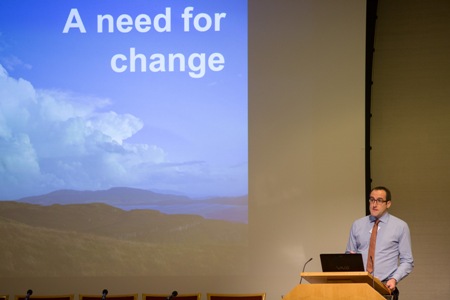
Download John Sawyer's presentation
Videos
The Conference morning and afternoon sessions were all captured on video. These are currently being uploaded to the NBN's YouTube channel and will be available to view shortly.
View the video of the first morning session below, with session times as follows:
Introduction by Professor Michael Hassell 00:00 – 01:54
Professor Ian Boyd 01:55 – 35:42
John Sawyer introduction 35:43 – 36:37
Katie Winney 36:38 – 56:45
Matt Davies 56:46 – 01:14:15:
View the video of the second morning session below, with session times as follows:
Special presentations by Professor Michael Hassell 00:00 – 07:48
John Sawyer introduction 07:49 – 08:47
Peter Doherty 08:48 – 31:45
John Sawyer 31:46 – 32:32
John Tweddle 32:33 – 37:38
Lori Lawson Handley 37:39 – 43:48
Chris Raper 43:49 – 49:05
Charles Roper 49:09 – 54:55
View the video of the first afternoon session below, with session times as follows:
Introduction by Professor Michael Hassell 00:00 – 02:02
Professor Chris Thomas 02:03 – 34:11
Dave Goulson 34:24 – 53:15
Savita Custead 53:16 – 01:11:45
View the video of the second afternoon session below, with session times as follows:
Second afternoon session, with session times as follows:
Michael Hassell – 00:00 – 00:17
Richard Pywell – 00:18 – 19:59
Michael Hassell – 20:00 – 20:26
John Sawyer – 20:27 – 44:25
Michael Hassell, closing remarks – 44:26 – 46:54
Students
The students that attended have been writing up their experience of the day. Catherine Chen and Elizabeth Arnold from Bangor University share their experiences here. Clare Gray from Imperial College, London shares her experience here. Takuji Usui from University of Edinburgh shares his experience here and Stefanie Bonat, also of Edinburgh shares her experience here. James Mudie of Nottingham University writes here, and Constantina Patsalou writes here. Eulalia Gomez Martin of the University of Greenwich writes here.
Your thoughts please
Don't forget to give us your feedback on the Conference as it will help us to determine the format of the next one, so your views are really important to us. Go to the survey.
More Tweets
The #NBNConf14 Twitter stream throughout the day demonstrated the energy, enthusiasm and excitement for the future of the NBN. Here are a few more…
We need to change… #NBNConf14 pic.twitter.com/HdIY1KKOWM
— Charles Roper (@charlesroper) November 21, 2014
#NBNConf14 sense of 'family' needed. Everyone supports everyone.
— ALERC NC (@ALERC_NC) November 21, 2014
Delighted for Val Burton to receive an @NBNTrust award at #NBNConf14…for entering over 12 mill biological records at BRC, a world record?
— BRC (@___BRC___) November 23, 2014
Hearing the word 'integration' used a lot by @DefraChiefScien at #NBNConf14. Yes! #LinkedData #opendata is fundamental to good integration.
— Charles Roper (@charlesroper) November 21, 2014
A lot of people/organisations doing some really great things with data and tech at #NBNConf14 How can we keep keeping each other up to date?
— Colin Campbell (@ColinHCampbell) November 21, 2014
'Good open data is liquid – it flows' and is traceable to it's origin: by @charlesroper #NBNConf14
— Thomas Starnes (@bio_carta) November 21, 2014
